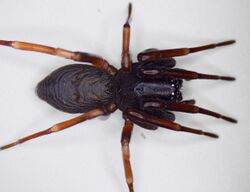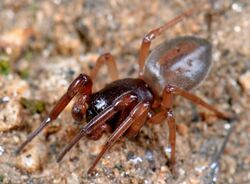Biology:Trachelidae
| Trachelidae | |
|---|---|

| |
| Cetonana laticeps | |

| |
| Trachelas pacificus, male | |
| Scientific classification | |
| Domain: | Eukaryota |
| Kingdom: | Animalia |
| Phylum: | Arthropoda |
| Subphylum: | Chelicerata |
| Class: | Arachnida |
| Order: | Araneae |
| Infraorder: | Araneomorphae |
| Family: | Trachelidae Simon, 1897[1] |
| Diversity | |
| 20 genera, 271 species | |
Trachelidae is a family of araneomorph spiders (more recently evolved spiders with inward-pointing chelicerae) first described by Eugène Simon in 1897 as a subfamily called "Tracheleae" ("Trachelinae" in modern terminology).[2] The Trachelidae family, also known as "ground sac spiders", is within the group of spiders known as the RTA clade, which includes mostly wandering spiders that do not use webs. Spiders in the Trachelidae family are characterized as being 3-10mm long and having a red cephalothorax and a yellow/tan abdomen. They are commonly found indoors.[3] It was placed in the family Clubionidae, then later in Corinnidae when the Clubionidae were split up. The first study that suggested Trachelidae should be considered its own family was done by Deeleman-reinhold in 2001 as part of an analysis of RTA Clade spiders.[4] An analysis by Martín J. Ramírez in 2014 suggested that it was not closely related to other members of the Corinnidae, and was better treated as a separate family.[5] It was then placed in the CTC clade of spiders, or the Claw Tuft Clasper clade,[6] which is a group of spiders that have two tarsal claws with tufts of hair.[7]
A major synapomorphy of Trachelidae is the reduction of leg spines. Other synapomorphies of the family include no scales, no epiandrous spigot, only one major ampullate gland in females, no median apophysis, and the secondary spermatheca are the same size as the primary.[8] Currently, there are 271 known species across 20 genera.
Genera
(As of July 2021), the World Spider Catalog accepts the following genera:[1]
- Afroceto Lyle & Haddad, 2010 – Africa
- Capobula Haddad, Jin, Platnick & Booysen, 2021 – South Africa, Lesotho
- Cetonana Strand, 1929 – Russia, Brazil
- Fuchiba Haddad & Lyle, 2008 – Africa
- Fuchibotulus Haddad & Lyle, 2008 – South Africa, Mozambique
- Jocquestus Lyle & Haddad, 2018 – Africa
- Meriola Banks, 1895 – South America, North America, Guatemala
- Metatrachelas Bosselaers & Bosmans, 2010 – Algeria, Europe
- Orthobula Simon, 1897 – Asia, Africa
- Paccius Simon, 1898 – Madagascar, Seychelles
- Paraceto Jin, Yin & Zhang, 2017 – China, Korea
- Paratrachelas Kovblyuk & Nadolny, 2009 – Asia, Algeria, Europe
- Patelloceto Lyle & Haddad, 2010 – Ethiopia
- Planochelas Lyle & Haddad, 2009 – Ghana, Uganda, Ivory Coast
- Poachelas Haddad & Lyle, 2008 – South Africa, Zimbabwe
- Spinotrachelas Haddad, 2006 – South Africa
- Thysanina Simon, 1910 – South Africa, Namibia, Tanzania
- Trachelas L. Koch, 1872 – Asia, Central America, North America, Caribbean, Spain, South America, Africa
- Trachelopachys Simon, 1897 – South America
- Utivarachna Kishida, 1940 – Asia
References
- ↑ 1.0 1.1 "Family: Trachelidae Simon, 1897". Natural History Museum Bern. http://www.wsc.nmbe.ch/family/114.
- ↑ Simon, E. (1897). Histoire naturelle des araignées (2 ed.). Paris. doi:10.5962/bhl.title.51973.
- ↑ "Family Trachelidae". https://bugguide.net/node/view/1017586.
- ↑ Deeleman-Reinhold, Christa L. (2001) (in en). Forest Spiders of South East Asia: With a Revision of the Sac and Ground Spiders (Araneae: Clubionidae, Corinnidae, Liocranidae, Gnaphosidae, Prodidomidae, and Trochanterriidae). BRILL. ISBN 978-90-04-11959-8. https://books.google.com/books?id=jtPFOzEx3vsC&q=Forest+spiders+of+South+East+Asia%3A+with+a+revision+of+the+sac+and+ground+spiders&pg=PA3.
- ↑ Ramírez, Martín J. (2014). The morphology and phylogeny of dionychan spiders (Araneae, Araneomorphae). Bulletin of the American Museum of Natural History. 390. pp. 331–335, 342.
- ↑ Lyle, Robin (August 2015). "Two New Species of the Afrotropical Sac Spider Genus Afroceto Lyle & Haddad, 2010 (Araneae: Trachelidae)". African Invertebrates 56 (2): 415–423. doi:10.5733/afin.056.0212. ISSN 1681-5556.
- ↑ "Dionycha" (in en), Wikipedia, 2020-10-23, https://en.wikipedia.org/w/index.php?title=Dionycha&oldid=984948519, retrieved 2020-11-30
- ↑ Rivera-Quiroz, F. Andrés; Alvarez-Padilla, Fernando (2015-08-07). "Three new species of the genus Trachelas (Araneae: Trachelidae) from an oak forest inside the Mesoamerican biodiversity hotspot in Mexico" (in en). Zootaxa 3999 (1): 95–110. doi:10.11646/zootaxa.3999.1.6. ISSN 1175-5334. PMID 26250328. https://www.biotaxa.org/Zootaxa/article/view/zootaxa.3999.1.6.
Wikidata ☰ Q17295296 entry
 |

